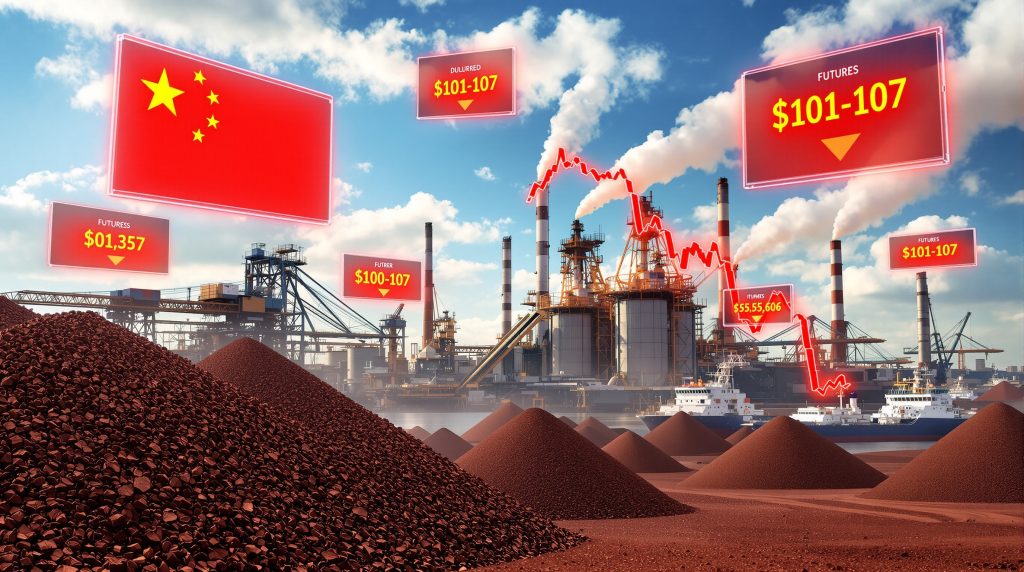Current Market Conditions and Price Levels
The iron ore price multi-month low China demand scenario has created significant volatility across global commodity markets throughout November 2025. Iron ore futures experienced sharp declines, with benchmark contracts reaching their lowest levels since mid-summer. The January contract on China's Dalian Commodity Exchange touched an intraday low of 756 yuan per metric ton ($106.23 USD), representing the weakest price point since July 10, 2025.
Furthermore, international markets reflected similar weakness, with Singapore Exchange December contracts falling to $100.85 per ton during early trading hours. This marked the lowest level since September 1, 2025, highlighting synchronized global pressure on iron ore valuations. By session close, the contract recovered marginally to 765 yuan ($107.40 USD).
Key Price Movement Indicators:
• Dalian January contract low: 756 yuan/ton ($106.23)
• Singapore Exchange December contract low: $100.85/ton
• Current exchange rate: $1 USD = 7.1230 Chinese yuan
• Time frame: Multi-month lows spanning July to November 2025
In addition, market participants interpret these multi-month declines as evidence of fundamental demand weakness in China. The iron ore price trends demonstrate synchronized movement across both Chinese domestic and international benchmark contracts, suggesting broad-based pressure rather than regional anomalies.
Why Are Chinese Steel Mills Reducing Iron Ore Consumption?
Chinese steelmakers face unprecedented margin compression as resilient raw material costs collide with softening downstream demand. Mills across the nation have initiated strategic production cuts and equipment maintenance schedules to avoid operating at unsustainable losses.
Financial Pressure Dynamics:
• Production costs exceeding revenue streams
• Voluntary equipment maintenance increasing industry-wide
• Strategic inventory optimisation to reduce working capital requirements
• Mill-level assessments prioritising financial sustainability over volume targets
However, the situation became more pronounced despite regulatory relief in key production regions. Environmental restrictions were lifted in northern China, including the major steel hub of Tangshan, on November 9, 2025. Mills remained cautious about ramping operations, indicating that financial constraints rather than regulatory barriers drive current production decisions.
Production Response Strategies
Regional steelmakers have adopted sophisticated approaches to managing the downturn. Rather than complete shutdowns, mills are implementing extended maintenance windows and optimising throughput rates. This strategic approach allows rapid response to improved market conditions without significant costs associated with full facility restarts.
The margin squeeze stems from iron ore demand insights showing elevated prices relative to finished steel product values. When input costs consume disproportionate revenue shares, mills face impossible economics that force rational production adjustments downward.
How Are Rising Port Inventories Affecting Market Dynamics?
Chinese port inventories reached 138.44 million metric tons as of November 7, 2025, representing a 2.1% weekly increase and the highest accumulation since March 21, 2025. This buildup creates a fundamental supply-demand imbalance that pressures spot prices and futures valuations.
Inventory Analysis:
| Metric | Current Level | Previous Week | Change |
|---|---|---|---|
| Total Inventory | 138.44M tons | 135.6M tons | +2.1% |
| Days of Supply | 45-50 days | 42-45 days | +3-5 days |
| Storage Utilisation | 85-90% | 82-87% | +3% |
Consequently, the inventory accumulation reflects import volumes exceeding consumption rates, creating downward pressure throughout the pricing structure. Each additional day of supply represents increased working capital tied up in storage, whilst high facility utilisation rates approach capacity constraints at major ports.
Supply Chain Bottleneck Effects
Port congestion and elevated storage costs compound the inventory challenge. With facilities operating at 85-90% capacity, additional incoming shipments face logistical constraints that can delay cargo handling and increase demurrage costs. This situation typically forces spot price discounts as sellers seek to expedite inventory turnover.
The timeline significance proves notable, with current levels representing the highest accumulation in approximately 231 days. This extended buildup period suggests persistent rather than temporary imbalance conditions affecting market fundamentals.
What Role Do Global Shipment Patterns Play?
Global iron ore shipments declined to two-month lows during November 2025, providing crucial price support that helped moderate futures contract declines. According to consultancy Mysteel, shipment volumes fell 8-12% below recent peak levels, creating temporary supply tightness despite Chinese demand weakness.
Shipment Impact Mechanics:
• Reduced global availability supports price floors
• Supply-side constraints offset regional demand weakness
• Two-month low suggests cyclical export patterns
• Coordinated reductions across major producing nations
The shipment reductions demonstrate how global supply factors can provide counterbalance to localised demand pressures. Major exporting regions, including Australia, Brazil, and India, appeared to coordinate volume adjustments that prevented steeper price declines during afternoon trading sessions.
Seasonal and Operational Factors
November typically represents a transitional period for mining operations, with Q3-Q4 shifts affecting export schedules. For instance, the onslow iron haulage update demonstrates how operational adjustments at major mining facilities can impact global supply chains.
Without these reduced shipments providing market support, the iron ore price multi-month low China demand scenario would likely have experienced more severe declines given the magnitude of Chinese demand weakness and rising port inventories.
How Are Geopolitical Factors Influencing Iron Ore Markets?
US-China trade relations showed signs of improvement on November 10, 2025, when China announced a one-year suspension of port fees on US-linked vessels. This concrete diplomatic gesture provided modest support to commodity markets by boosting risk appetite and reducing trade friction concerns.
Trade Policy Developments:
The port fee suspension represents a unilateral Chinese concession designed to normalise economic relations with the United States. Market participants interpreted this measure as evidence of easing tensions between the world's two largest economies, which typically benefits industrial commodity pricing.
Policy Signal Analysis:
• One-year timeline indicates medium-term commitment
• Applies to US-linked vessels (scope includes flagged ships and related entities)
• Concurrent with iron ore weakness, providing price floor support
• Part of broader diplomatic engagement efforts
Furthermore, the timing proved significant, with the announcement occurring during the iron ore price multi-month low China demand period. This geopolitical positive helped establish price support levels that might otherwise have been breached during fundamental weakness. The broader US-China trade impact continues to influence commodity markets significantly.
Economic Context
Broader Chinese economic indicators showed gradual improvement, with producer price deflation easing and consumer prices returning to positive territory. These developments reflect government efforts to address industrial overcapacity and reduce destructive competition among domestic firms, creating a more supportive environment for commodity demand recovery.
What's Happening with Related Steelmaking Materials?
Other essential steelmaking inputs followed iron ore's downward trajectory, demonstrating synchronised weakness across the ferrous metals complex. Coking coal futures declined 1.02% whilst coke contracts dropped 1.19%, maintaining strong correlation with iron ore price movements.
Raw Materials Performance:
• Coking coal: -1.02% daily decline
• Coke contracts: -1.19% daily decline
• Strong correlation maintained with iron ore weakness
• Input cost pressures affecting entire steelmaking supply chain
However, finished steel products showed surprising resilience compared to raw material inputs, suggesting downstream demand conditions remain relatively stable despite margin pressures at mill level.
Steel Product Divergence
| Product | Price Change | Market Signal |
|---|---|---|
| Rebar | +0.26% | Construction demand steady |
| Hot-rolled coil | +0.06% | Manufacturing activity stable |
| Stainless steel | +0.28% | Specialty applications growth |
| Wire rod | -0.12% | Infrastructure projects slowing |
This divergence between raw materials and finished products indicates that steelmakers are absorbing margin compression rather than passing costs through to end users. The pattern suggests competitive pressures prevent mills from raising finished product prices despite elevated input costs.
Additionally, the synchronised decline across steelmaking inputs reflects fundamental changes in Chinese steel production economics. When mills reduce throughput due to margin pressures, demand for all primary inputs decreases proportionally, creating correlated price movements throughout the ferrous complex.
Are There Signs of Market Stabilisation?
Technical analysis identifies key support levels around $100-102 per ton for benchmark contracts, with resistance zones near $110-115 per ton. Current trading patterns suggest consolidation within this range as markets seek equilibrium between fundamental pressures and supply-side support.
Technical Support Analysis
The $100.85 intraday low on Singapore Exchange contracts represents a significant technical level that attracted buying interest. Similarly, the 756 yuan low on Dalian contracts provided a psychological support zone that prevented deeper declines, as reported by Energy News.
Seasonal Demand Considerations:
Historical patterns suggest potential demand recovery during China's traditional construction season, typically occurring in spring months. Nevertheless, structural changes in Chinese steel consumption patterns may limit recovery magnitude compared to previous cycles.
Market Stabilisation Indicators:
• Technical support holding at key price levels
• Reduced global shipments providing supply-side relief
• Geopolitical improvements supporting risk appetite
• Inventory accumulation potentially nearing peak levels
The combination of technical support, supply-side adjustments, and geopolitical improvements creates conditions for potential price stabilisation. However, the price decline amid surplus remains the dominant factor affecting market sentiment.
What Do Long-Term Projections Suggest?
China's steel demand evolution indicates structural transformation rather than cyclical adjustment. Industry forecasts suggest Chinese steel production will gradually decline toward 2035, following six consecutive years exceeding 1 billion metric tons annually. This fundamental shift carries significant implications for global iron ore demand patterns.
Structural Demand Changes:
• Infrastructure spending replacing property development as primary driver
• Quality focus replacing volume-based production strategies
• Gradual transition toward sustainable production methods
• Potential for increased demand volatility during transition periods
Global Supply Response
Major iron ore producers are reassessing expansion plans and production schedules in response to evolving Chinese demand patterns. This supply-side adjustment process typically occurs with significant time lags, potentially creating better supply-demand balance over medium-term horizons.
Investment Strategy Implications:
The transition from volume-based to value-based steel production suggests premium ore grades may command stronger pricing power relative to lower-grade materials. Producers with high-grade reserves and efficient operations are likely to maintain competitive advantages during industry consolidation.
Market Psychology Factors:
Long-term projections must account for policy-driven demand fluctuations as Chinese authorities balance economic growth targets with environmental sustainability goals. This policy dynamic creates periodic volatility that can override fundamental supply-demand trends in shorter time frames.
Key Takeaways for Market Participants
Current iron ore price multi-month low China demand conditions reflect fundamental shifts in Chinese steel economics rather than temporary cyclical adjustments. Multiple factors converge to create sustained pressure on pricing, requiring strategic responses from market participants across the supply chain.
Short-term Outlook:
• Continued price pressure until Chinese steel margins improve significantly
• Inventory normalisation required before sustained recovery begins
• Geopolitical developments may provide periodic support but insufficient to overcome fundamentals
• Technical support levels likely to be tested multiple times
Medium-term Considerations:
• Structural changes in Chinese steel demand patterns becoming permanent
• Infrastructure-led recovery potential limited by economic headwinds
• Supply-side adjustments by major producers creating rebalancing opportunities
• Quality premiums likely to increase for high-grade ore products
Risk Management Priorities
Market participants should monitor Chinese steel mill margin recovery as the primary indicator for demand improvement. Port inventory levels provide secondary signals for supply-demand rebalancing, whilst geopolitical developments offer tactical trading opportunities within broader fundamental trends.
Investment Framework:
• Focus on high-grade ore producers with cost advantages
• Monitor Chinese infrastructure spending announcements for demand catalysts
• Track global supply capacity adjustments for medium-term price impact
• Consider policy-driven volatility in position sizing and timing decisions
"The iron ore market's current trajectory reflects complex interactions between Chinese economic transition, global supply dynamics, and geopolitical developments. Understanding these multifaceted relationships provides essential context for navigating price volatility and identifying strategic opportunities within the evolving landscape."
Disclaimer: This analysis contains forward-looking projections based on current market conditions and historical patterns. Iron ore prices are subject to significant volatility driven by economic, political, and operational factors that may differ materially from expectations. Readers should conduct independent research and consider professional advice before making investment decisions.
Ready to Capitalise on Iron Ore Market Volatility?
Discovery Alert's proprietary Discovery IQ model delivers real-time alerts on significant ASX mineral discoveries, instantly empowering subscribers to identify actionable opportunities ahead of the broader market during volatile periods like the current iron ore downturn. Begin your 30-day free trial today and secure your market-leading advantage whilst others struggle with multi-month lows and shifting demand patterns.




